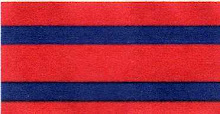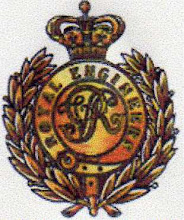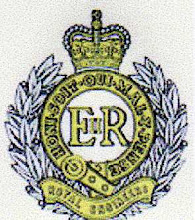1900 - 1914
During the early 1900, practically the whole of the Royal Engineer Field Troops had been shipped out to South Africa, leaving none available for other wars, if necessary.
Authority was therefore given by the Secretary of State, to raise a large number of additional units, which included the following:
C and D Pontoon Troops
8 Field Companies – 46, 54, 55, 56, 57, 58, 59 and 60.
2 Field Park Companies – 3 and 4
Four Balloon Sections
5 Fortress Companies
53rd Railway Company
3rd Telegraph Division
The Royal Engineer March
"Wings" was adopted as the RE Quick March in 1870.
1902 the "Wings" was Officially recognised.
It consists of two Tunes - The path across the hills (German) and Dolores (Miss Dickinson).
The words are:
Wings to bear me over mountain and vale away;
Wings to bathe my spirit in morning's sunny ray.
Wings that I may hover at morn above the sea;
Wings through life to bear me, and death triumphantly.
Wings like youth's fleet moments which swiftly o'er me passed;
Wings like my early visions, too bright, too fair to last.
Wings that I might recall them, the loved, the lost, the dead;
Wings that I might fly the past, long vanished.
Wings to lift me upward, soaring with Eagle flight;
Wings to waft me 'heav'ward to bask in realms of light.
Wings to be no more wearied,lulled in eternal rest;
Wings to be sweetly folded where Faith and Love are blessed.
---------------------------------------------------------------------------------
16th May 1900
59 Field Company RE was formed at Chatham, the Company Staff on formation was:
OC Captain HW Weekes
CSM T. Duckett
QMS Sgt A. Hilton
Pay Cpl G. Stocks
September 1900
The annual course of Musketry was performed at Gravesend, Spr A. Woodhead securing “Company Shoot” with a total of 128 points, he was subsequently promoted to L/Cpl.
30th October 1900
Lt. EN Mozeley assumes Command of the Company.
August 1903
Company moved to Salisbury Plains
August 1905
Company moved to Bulford Barracks.
Here they practised Marching, Entrenchment, Field Defences, Bridging, Pontooning and Demolitions.
November 1906
Company moved to Curragh (S. Ireland) attached to 5 Division.
Working alongside the Essex Regiment and East Lancashire Regiment.
The Company carried out Local projects, plus assistance to the Infantry Regiments and primarily to continue with improvements to the RE accommodation.
1912
Major G Walker assumes Command of the Company.
July 1914
The Company is ordered to prepare for the move to the Aisne, France.
4th August 1914
Fortunately, everything had been worked out the previous Winter, so everyone knew what had to be done and when to do it.
The first time the Company paraded, it made a “brave” show, 75% of the men and horses were Reservists, or newly off Farms.
The Reservists were put through a short course of Musketry, as some had never held a weapon.
Each section of the Company was organised as a self-contained unit. Each section carried it’s own food in it’s own carts.
Each section also had it’s own farrier, wheeler, collar maker and cooks.
The result of this logistical set-up, was that the subalterns were able to carry on alone and the men were always fed.
16th August 1914 - Le Havre
The Company left Curragh, sailed from Dublin to Le Havre.
18th August 1914 - Mons
The Company arrived in Le Havre, then followed an uncomfortable train journey, via Amiens and Le Cateau to Landrecies.
Then followed a march to Mons.
The Company was ordered to put the Bridge heads over the Mons Canal, in a state of Defence.
23rd August 1914 - Le Cateau
The Company were given 3 Bridges to demolish and although these were successful, it did not stop the German advance for too long.
The Company then helped the Infantry construct trenches at Le Cateau, here the Sappers behaved exemplary, standing to rigidly, whilst others around them retired. The Officers gradually steadied the Infantry men, by using the Sappers as an example.
After the battle of Le Cateau, the Company moved to St. Quentin and Ollegy, carrying out more bridge demolitions en-route.

The aircraft is an Albatross C1 observation plane.
The picture (from L to R) shows a double belt of wire covering the two lines of trenches, that form 'the front line', behind which are communication trenches, protected by wire and redoubts facing outwards. Behind these again, is another belt of wire and then two trench lines of the second or support line of defences.
A) Russian Saps - a buried trench allowing troops to emerge in the heart of no-mans land.
B) Deep belt of wire. Note that narrow passages through the wire would be built in the system, to allow parties of troops to access no-mans land for raids or attacks.
C) Listening post or machine-gun position set slightly ahead of the main trenches.
D) Site of a dug-out just behind the main trenches.
E) Redoubt dug into the communication trench for flank defence, incase of an enemy break-in.
F) Underground Medical aid post.
G) Telephone cable head. A tactical command post cannot be too far away.
10th September 1914 - The Marne
The Company reached The Marne, at a place called Mery. Here they were told to wait for orders.
Eventually the order to advance was received and they worked with 13 Brigade / 5 Division.

Missy Bridge over the Aisne 14th September 1914 – Near Moulin des Roches
The bridge had 3 x 50ft spans of which 2 were broken. The piers were 15ft high and the water 10 to 12 ft deep. A nice job for a Company with nothing but what they carried in tool carts.

The West Kent Regiment were ordered to cross at Missy, at all costs. It was impossible to repair the bridge in such short time, with the materials available.
The use of Rafts was then suggested.
The bridge was under constant machine gun fire by the Germans on the far bank, which did not help matters.
Five rafts were made, one small boat, one made of planks and three of straw and wagon covers.
A man swam over with a line and managed to get cables over and fixed.
With this, the outfit started crossing, 3 Battalions of the 13th Brigade crossed the river before daybreak.
A violent battle started in Missy, with the river under heavy machine gun fire.
Captain William Henry Johnston and Lt Flint took command of the raft crossing and were working a raft to and fro, carrying wounded one way and ammunition the other. Johnston and Flint continued this until 7 pm, when they were relieved, quite worn out.
Johnston received a V.C. for this and Flint a D.S.O.

Citation from London Gazette 25th November 1914.
At Missy on 14th September 1914, under constant heavy fire all day until 7 pm, worked with his own hands, two rafts, bringing back wounded and returning with ammunition, thus enabling the advanced Brigade, to maintain its position across the river”
30th September 1914 - Pontoise
Major Walker received a message by despatch rider from the 2IC of the West Kents, that the Suspension Bridge at Pontoise was not properly down. Pontoise was about 3 hours march rearwards and no obvious solution was evident.
Lt Pennycuik RE volunteered to go back with Lt West (despatch rider) to see if anything could be done. The motor cycle was loaded up with a box of fourteen gun-cotton slabs, on top of which was mounted Pennycuik with his pockets full of primers and detonators.
Major Walker suggested that the charges should be placed on top of the piers and not in the centre of the bridge.
About 4 hours later, they both turned up smiling. They got down to the river safely and saw no Germans, mounted one pier, placed and lit their charge, result was a misfire. Not daunted they put in new detonators and set it off successfully; the shock pulled the cable off the other pier and made a good job of it.
They were both awarded the DSO and they deserved it.
2nd October 1914
The Chief Engineer gave the warning order of a move from the very comfortable Couvrelles Chateau.
Bridging equipment arrived 5 weeks after its loss at Mons.
This highlights the extent of the logistical delay experienced by all.
14th October 1914
Captain Pennycuik was wounded and evacuated. He was the first
Officer casualty.

18th October 1914 - Lorgie
Arrived at Lorgie, to strengthen the Town and defence positions.
14 Brigade was involved in a very hot defensive fire fight.
Lt Carr RE was casevaced with shrapnel wounds.
Shortly after the Battle, Major Walker received an enquiry from the Compensations Commission in France, asking “Had he really had the material he signed for, had he really used it and for what, had he recovered any of it and returned it to the owners and finally, could he rembember what was the distance apart in inches, of the barbs on the wire he had used”. As can be imagined, no reply was ever sent.
The Company was replaced by the Indian Corp – 1st (Bombay) Sappers and Miners.
The 5th Division was now in Reserve.

6th November 1914 - Ypres
Orders arrive to march to Ypres and report to 1st Corps.
On arriving at Ypres, it was found to be on fire and undergoing quite a heavy bombardment.
The Company met up with 56 Field Company and were tasked to the 9th Infantry Brigade, wiring and trenching and were soon engaged in the first battle of Ypres
Jam pot bombs were much in favour with the ‘high command’ and in fact, anyone who had not got to touch them.
Most RE Companies had a “factory” , the manufacture was simple, take a tin jam pot, fill it with shredded gun cotton and tenpenny nails ‘mixed to taste’, insert a No. 8 detonator with a short length of Bickfords fuze, clay up the lid and you have a jam pot bomb.
In action it was a difficult and dangerous weapon to use. The procedure was to light the fuse with a match, if you had one and could light it, then throw the bomb for all you were worth.
11th November 1914
The Germans launched their last offensive, during which, the Company acted as an Infantry Company.
Later, the GOC was to state the men showed great character.
25th November 1914 - Dranoutre
The Company moved back to Dranoutre and worked on the defences of the 13th Brigade line at Lindenhook.
Tasks included Trenching, Wire, Tunneling, Road works, Infantry assistance, Water Supply and pumping.
1st December 1914
Captain WH Johnston VC, assumed command of the Company.





